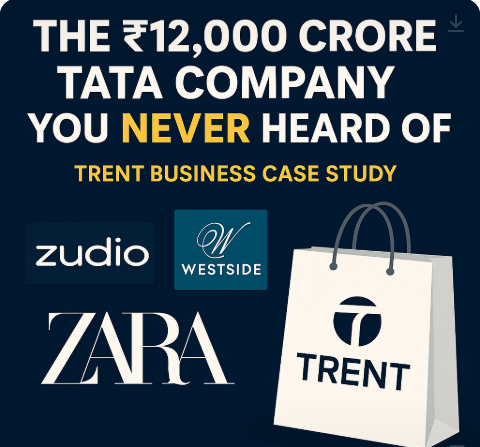Introduction
See, last week I needed some clothes, so I went shopping. I went to multiple stores including Zara, Zudio, and Westside. I bought clothes from each of these stores, and it was only after I came back home that I realized I paid the money to the same company.
This Tata company makes more than ₹12,000 crore in revenue and might become the biggest fashion company in the country very soon. A company that is not famous by its own name but is behind running three of the biggest fashion brands of the country – Zudio, Westside, and Zara.
The company I’m talking about is Trent Limited, a retail masterstroke by the Tata Group that has given its investors almost 2,000% return in the last 5 years.
The Rise of Trent Limited
In this episode, we’ll dive into the three core insights that Trent Limited has cracked to become the ultimate fashion retail king of India. But if you’re new to the channel, then hello – you’ve landed at GrowthX, an invite-only community of over 3,000 members for product marketing, business leaders, and also founders from the startup ecosystem.
Coming back to Trent – let’s get some context first. Trent has got many investors excited recently, but this is a 25-year-old company we’re talking about.
When you compare Trent with giants like Reliance Retail, ABFRL (Aditya Birla Fashion), or Shoppers Stop, Trent stands apart – in terms of brand impact, scale, or even margins. It has an entire universe of companies in itself.
House of Brands: A Strategic Masterstroke
1. Understanding the Brand Structure
There are two types of entities under Trent:
- Self-owned brands like Westside, Zudio, and Utsa (a cosmetic brand)
- Joint Ventures (JVs) like Zara (with Inditex), Star Bazaar (grocery retailing), and Booker (grocery for HoReCa businesses)
But in this blog, the focus is on the fashion business – which makes up over 90% of Trent’s revenue.
Trent launched:
- Westside in 1998
- A JV with Zara in 2010
- Zudio in 2016
Why three brands under one company? Wouldn’t it cannibalize each other’s market? Not really.
2. Understanding India’s Segmented Fashion Market
India is a country with multiple socio-economic layers – the team at Tata divided them metaphorically into Poland, Singapore, and Mexico. Each segment has:
- Different income levels
- Different aspirations
- Different brand choices
Here’s the breakdown of average selling prices (ASP):
- Zudio: Under ₹999
- Westside: ₹1,500–₹2,000
- Zara: ₹2,250+
This segmentation lets them target different consumer layers without diluting brand perception.
Positioning Strategy: Why It Works
Tata launched Zudio as a separate brand to prevent diluting Westside’s brand image. Zudio’s quality is intentionally lower to maintain low pricing, so mixing it with Westside’s premium image would hurt the latter’s reputation.
By offering distinct brand identities and marketing communications, they ensured clarity in consumers’ minds.
Also, their store placement strategy is genius – even within the same mall, Zara, Westside, and Zudio are placed far apart in distinct sections aligning with their brand perception.
The Scale Game: Massive Expansion With Smart Retail Models
1. Rapid Store Growth
In 2019:
- Westside had 150 stores
- Zudio had 44 stores
By 2024:
- Westside has 232 stores
- Zudio has 545 stores (more than 5x growth!)
This expansion focused not just on Tier-1 cities but extensively on Tier-2 and Tier-3 towns.
2. Retail Models
Trent uses a mix of retail models:
- FCO (Franchisee-Owned, Company-Operated) for Zudio
- COCO (Company-Owned, Company-Operated) and FCO for Westside
This helps them stay asset-light while maintaining operational control. Zudio franchisees pay for the lease and take a 16% revenue share, while Trent handles store operations.
Operational Efficiency: The Secret Sauce
1. Store-Level Execution
Two main metrics:
- Same Store Sales Growth (SSSG) – consistently improving
- Revenue per Square Foot – ₹18,000/sq ft for Zudio and ₹12,000/sq ft for Westside (industry average is ₹10,000/sq ft)
2. Fast Fashion + Private Labels
Trent applies Zara’s fast fashion model:
- Launching fresh collections bi-weekly or weekly
- Reacting to social media trends instantly
They also leverage private labeling – where in-house brands dominate, leading to better margins and stronger brand identity.
Westside, for instance, has built 5+ in-house brands, recognized by customers individually now.
Upselling: A Revenue Booster
Trent excels at upselling:
- Wallets, perfumes, accessories near counters
- Even Westside memberships (over 1 crore members!)
This “one-stop shopping” strategy capitalizes on customer convenience and psychology.
Conclusion
These were the three key insights that helped Trent Limited become one of India’s most successful retail fashion companies:
- House of Brands Strategy
- Smart Retail Expansion via FCO & COCO
- Fast Fashion & Operational Efficiency
With a revenue of ₹12,000+ crore and counting, Trent is silently powering India’s fashion retail revolution – and you may not even realize you’re contributing to it every time you shop at Westside, Zara, or Zudio.
FAQs
Q1: Who owns Trent Limited?
Trent Limited is a part of the Tata Group, one of India’s largest and most respected conglomerates.
Q2: What are the main fashion brands under Trent?
The key brands include Zudio, Westside, and Zara (JV with Inditex).
Q3: Why does Trent use different store names?
To target different customer segments based on pricing, quality, and aspirations without overlapping brand identities.
Q4: What retail model does Zudio use?
Zudio primarily uses the FCO (Franchisee-Owned, Company-Operated) model.
Q5: How is Trent different from Reliance Retail or ABFRL?
Trent focuses on private label brands, fast fashion, and lean retail models, which offer better control and margins compared to multi-brand retailers.










